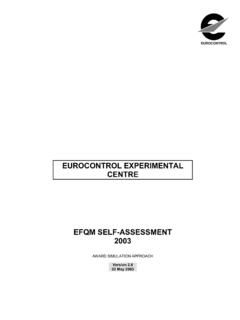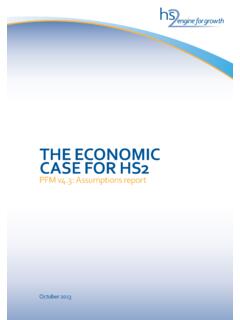Transcription of PASSENGERS’ CHOICE BETWEEN HIGH-SPEED TRAIN AND …
1 PASSENGERS CHOICE BETWEEN HIGH-SPEED TRAIN AND AIR TRANSPORT Antonia Cokasova, EUROCONTROL Experimental Centre (France) and University of Zilina (Slovakia) Abstract Air and rail are not necessarily competing modes of transport. The complementary capabilities and characteristics of these two modes together can satisfy the principal requirements of the passenger transportation market. The objective of this study is to demonstrate the necessity and importance of HIGH-SPEED TRAIN inter-modal connections BETWEEN European airports. In particular it will focus on how passenger needs are addressed by inter-modal air-rail links. There are numerous advantages to this proposal, principally that it releases runway and ATC resources, offers immediate relief to congestion, reduces negative environmental impacts, and finally improves ground access to airports.
2 Inter-modality from a passenger perspective investigates how to make inter-modality work by satisfying passenger needs, so that the passengers behaviour can be used to help to improve airport capacity problems use of high speed TRAIN links instead of short haul flights could release ATM and airport capacity for users that have no alternative transport. passenger perspective is the key element; it is rather impossible to develop a well-organised and satisfactory intermodal interchange node with efficient baggage handling logistics and integrated ticketing if there is no passenger feedback. 1 Transport in Europe Air traffic Passengers are requesting fast, efficient and in many cases, environmentally friendly transport connections.
3 Considering the recent situation in aviation, this requirement is very hard to fulfil, especially because of rising delays and congested airspace and airports. In 2002 the traffic in Europe decreased by instead of the assumed increase of At the same time the average delay per flight was lower at minutes than the minutes forecast, In 2003 the traffic increased by showing a fast recovery fostering predictions of a 4% traffic increase during 2004 [1]. ATFM delays are caused by regulations to protect either airports or en-route sectors from traffic overload. The contribution of the airports to the total delay, which has been around 22% during the previous 5 years, increased significantly in 2002 to 34% and further increased in 2003 to 46%.
4 Also 66% of airport derived ATFM delays were caused by only 8 European airports (Frankfurt, Rome, Paris, London, Milan, Zurich, Amsterdam and Barcelona), yet these 8 airports handle only 19% of European traffic [1]. Based on these figures airport congestion is seen as a mounting problem and is already a limiting factor at many airports. Many of the international hubs are operating at their maximum throughput; some have already reached their operating limits as prescribed by physical and as well political and environmental constraints. The use of such airports is heavily regulated and future traffic distribution patterns are likely to generate congestion at airports that currently do not experience capacity problems.
5 The European Union has undergone significant changes with the accession of ten new member states, bringing the population to approximately 500 million. The accession of these ten states to the EU will vastly enhance the potential mobility of their citizens, offering both new employment and leisure possibilities. As a consequence, significant regional growth in air transport demand can be expected shifting the main traffic flow from north-south dominated to a more east-west oriented pattern. Central and Eastern European airports might experience capacity shortfall for the very first time since most of the airports are not ready for dramatic traffic increase. Travel distances in Europe are such that more than 50 % of European flights are of less than 370 ; a statistic heavily influenced by airlines use of a hub and spoke operation.
6 European airlines are operating fragmented networks. 10% of the city-pairs in Europe represent 50% of the air traffic. Figure1. Short-haul flights in Europe Source: EEC, NCD data 2004 Figure2. City-pairs in Europe Source: EEC, NCD data 2004 Hub airports For many significant city pairs, transfer via a hub incurs a large time penalty. Replacement of direct flights by indirect flights via hub airports has resulted in a reduction in the average size of aircraft, because airlines prefer to run more frequent flights rather than have a more limited schedule using larger aircraft. Unfortunately, not only does this cause congestion on the ground; it also means that the task of controlling all the aircraft trying to use a limited amount of space becomes more complex.
7 As air traffic is concentrated at hub airports, constraints arise such as long walking distances [2]. Passengers must wait at large hub airports for the connecting flight generally longer than it would be necessary in case of point-to-point transport, since the flight co-ordination is less efficient and minimum connecting time is higher, especially at main hubs like Paris CDG and London Heathrow. Large hubs have longer waiting times than the smaller ones (Frankfurt Main, Amsterdam Schiphol), even though one would expect shorter waiting times given the higher frequencies of services [3]. If air traffic evolves along the lines of recent predictions and the European Union accession results in significant air traffic growth operating under conditions of limited airport and airspace capacity while airlines maintain a hub & spoke way of operating then soon the European air traffic management system will become an extremely saturated network facing congestion problems as never experienced before.
8 passenger satisfaction The central research theme of the thesis Inter-modality from passenger perspective investigates mutual satisfaction of two sets of needs how to make air-rail inter-modality work towards passenger satisfaction, so passengers can assist in releasing constrained airport and ATM capacity by using high speed TRAIN instead of short haul flights A shift in passenger movement from air to rail will ease the congestion problems in the air transport industry (which are expected to intensify). It can release ATC and runway resources, have a positive environmental impact, allow the growth of airlines and airports (in passenger numbers) and bring to the rail industry the standard and skills developed in the airline industry, as well as other benefits.
9 But most of all it will allow more passengers to reach their destinations, without facing difficult congestion constraints. Many questions in particular related to passenger perspective of intermodal transport remained unresolved. 2 HIGH-SPEED trains in Europe The development of HIGH-SPEED TRAIN services has been seen by many as a forward looking objective of European transport policy. high speed TRAIN (HST) is the only mode of transport with a commercial speed that makes it possible to compete with air services on short haul routes in terms of journey time. It is important to remember that, almost regardless of any other advantages in shifting traffic from air to rail, it is the travel time feature that will determine the scale of any likely passenger shift.
10 HST is not only increasing its operating speed but as well rapidly spreading its infrastructure all over Europe. At the moment in Europe there are 3039 km s of HIGH-SPEED lines in operation, 2556 km s under construction and another 1736 km s projected. If construction continues as projected there will be up to 10 000 km s of HIGH-SPEED and upgraded lines in Europe by 2020. At the moment there are 9 countries in Europe who operate HST services (Belgium, Denmark, France, Germany, Italy, The Netherlands, Spain, Sweden and UK) with maximum speed of up to 350 km/h [4]. 50% of the flights fly less than 370 NM0%10%20%30%40%50%60%70%80%90%100%05001 00015002000250030003500400045005000NM% of the flightsX% of the CP represent Y% of the traffic0%10%20%30%40%50%60%70%80%90%100% 0%10%20%30%40%50%60%70%80%90%100%% o f C P% traffic Figure3.




